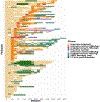Characteristics of Older Patients With Immunotolerant Chronic Hepatitis B Virus Infection
- PMID: 35843468
- PMCID: PMC10363409
- DOI: 10.1016/j.cgh.2022.06.015
Characteristics of Older Patients With Immunotolerant Chronic Hepatitis B Virus Infection
Abstract
Background & aims: Most patients in the immunotolerant (IT) phase of chronic hepatitis B (CHB) transition to the immune active (IA-hepatitis B surface antigen [HBeAg]+) phase by early adulthood. We examined characteristics of adults in the IT vs IA-HBeAg+ phase and rate of transition from IT to other phases of CHB, with a focus on those ≥40 years.
Methods: Demographic, clinical, and virologic characteristics of participants in the Hepatitis B Research Network adult cohort study with IT CHB (alanine aminotransferase ≤1.5 × upper limit of normal, hepatitis B virus DNA >107 IU/mL) were compared by age category, and to those with IA-HBeAg+ CHB in cross-sectional analysis. This study received institutional review board approval at all participating centers.
Results: Of 107 adult IT participants, 52 (48%) were <30, 33 (31%) were 30 to 39, and 22 (21%) were ≥40 years old (maximum, 71 years). Among IT groups, the proportion born in Asia and duration of CHB were greater in older IT groups, but virologic and liver disease characteristics were similar. Compared with IA-HBeAg+ participants (n = 192), IT participants were younger, fewer were men, more were Asian, and platelets, qHBsAg, and qHBeAg levels were higher. Similar differences were observed when comparisons were made with the ≥40 years IT group. Among IT participants, 60 (56%) transitioned during 206 person-years of follow-up. The phase transition rate per 100 person-years was highest in the <30 years group (33.0 [95% confidence interval [CI], 23.4-46.7]) vs the 30 to 39 years group (24.8 [95% CI, 15.6-39.4]) and ≥40 group (27.4 [95% CI, 14.8-50.9]), but 95% CIs overlapped.
Conclusions: In a large North American population, over 50% of adults in the IT phase of CHB were ≥30 years and 20% were ≥40 years old, but older IT patients had similar characteristics and rates of transition as younger IT patients.
Keywords: Chronic HBV Infection; Immune Active; Immunotolerant (IT); Phase Transition.
Copyright © 2023. Published by Elsevier Inc.
Conflict of interest statement
Conflicts of interest
These authors disclose the following: Jordan J. Feld reports research support from Enanta, Gilead, and Janssen; and consultant for Abbvie, Antios, Arbutus, Enanta, Gilead, GSK, Janssen, and Vir Biotechnology. Wendy C. King reports research support from Abbvie. Kyong-Mi Chang reports Advisory Committee for Arbutus Inc. Norah Terrault reports research support from Gilead Sciences, GSK, and Roche Genentech; consulting for Exigo, Saol Therapeutics and Moderna. Robert P. Perrillo reports research support from Dynavax and served as a consultant for Assembly Biosiences. Mandana Khalili reports research support from Gilead Sciences Inc and consults for Gilead Sciences. Harry LA Janssen reports consultant fees and/or grant support from BMS, AbbVie, Gilead Sciences, Novartis, Roche, Janssen, Arbutus and VIR. Anna S. Lok reports grants from Bristol Myers Squibb, Gilead Sciences, and TARGET, and served as consultant/advisor for Arbutus, Clear B, Enanta, Enochian, Gilead Sciences, GlaxoSmithKline, GNI, Janssen, and TARGET. The remaining authors disclose no conflicts.
Figures


References
-
- Feld JJ, Heathcote EJ. Hepatitis B e antigen-positive chronic hepatitis B: natural history and treatment. Semin Liver Dis 2006;26:116–129. - PubMed
-
- Yang HI, Yuen MF, Chan HL, et al. REACH-B Working Group. Risk estimation for hepatocellular carcinoma in chronic hepatitis B (REACH-B): development and validation of a predictive score. Lancet Oncol 2011;12:568–574. - PubMed
-
- Chen CJ, Yang HI, Su J, et al. REVEAL-HBV Study Group. Risk of hepatocellular carcinoma across a biological gradient of serum hepatitis B virus DNA level. JAMA 2006;295:65–73. - PubMed
-
- European Association for the Study of the Liver. EASL 2017 Clinical Practice Guidelines on the management of hepatitis B virus infection. J Hepatol 08 2017;67:370–398. - PubMed
Publication types
MeSH terms
Substances
Grants and funding
- UL1 TR001111/TR/NCATS NIH HHS/United States
- U01 DK082943/DK/NIDDK NIH HHS/United States
- U01 DK082923/DK/NIDDK NIH HHS/United States
- UL1 TR000058/TR/NCATS NIH HHS/United States
- M01 RR000400/RR/NCRR NIH HHS/United States
- U01 DK082867/DK/NIDDK NIH HHS/United States
- U01 DK082874/DK/NIDDK NIH HHS/United States
- UL1 RR024986/RR/NCRR NIH HHS/United States
- U01 DK082919/DK/NIDDK NIH HHS/United States
- U01 DK082927/DK/NIDDK NIH HHS/United States
- U01 DK082872/DK/NIDDK NIH HHS/United States
- P30 DK050306/DK/NIDDK NIH HHS/United States
- M01 RR000040/RR/NCRR NIH HHS/United States
- U01 DK082871/DK/NIDDK NIH HHS/United States
- U01 DK082944/DK/NIDDK NIH HHS/United States
- U01 DK082864/DK/NIDDK NIH HHS/United States
- U01 DK082843/DK/NIDDK NIH HHS/United States
- U01 DK082863/DK/NIDDK NIH HHS/United States
- UL1 TR000004/TR/NCATS NIH HHS/United States
- U01 DK082866/DK/NIDDK NIH HHS/United States

